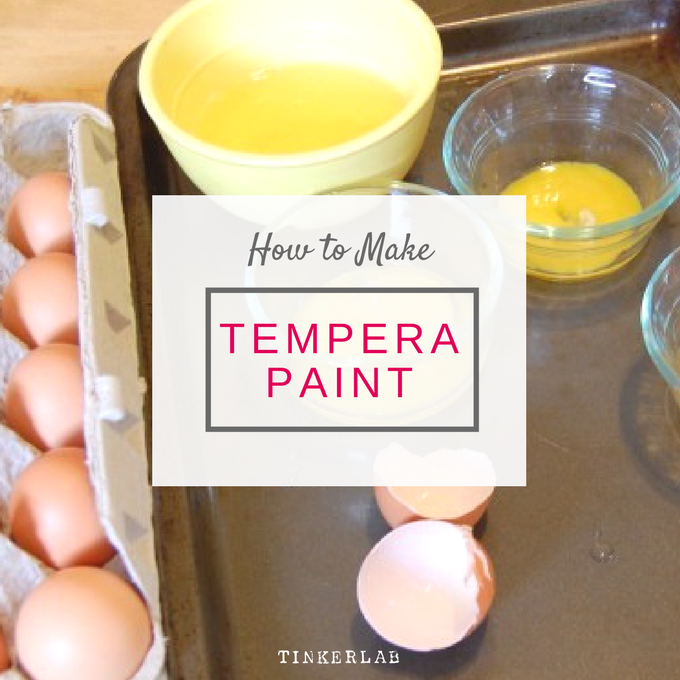 Today I’m sharing how to make homemade tempera paint. This paint is beyond simple, made from eggs and food coloring, and it will last indefinitely once dry.
Today I’m sharing how to make homemade tempera paint. This paint is beyond simple, made from eggs and food coloring, and it will last indefinitely once dry.
I’ve been interested in whipping up a batch of homemade egg tempera paint for a while, and was eager to try this with my kids.
History of Egg Tempera Paint
Do you know the history of egg tempera paint? It’s quite interesting, actually.
Egg tempera was wildly popular amongst Early Renaissance artists (Botticelli, Giotto, Fra Angelico) and then fell out of use with the Late Renaissance artists (Leonard da Vinci, Michelangelo) when oil paint was introduced. To make egg tempera paint, powdered pigments culled from things such as stones, sticks, bones, and the earth were mixed with water and then tempered with a binding agent such as an egg. And when they were tempered with eggs, they were called egg tempered paints and eventually earned the nickname Egg Tempera.
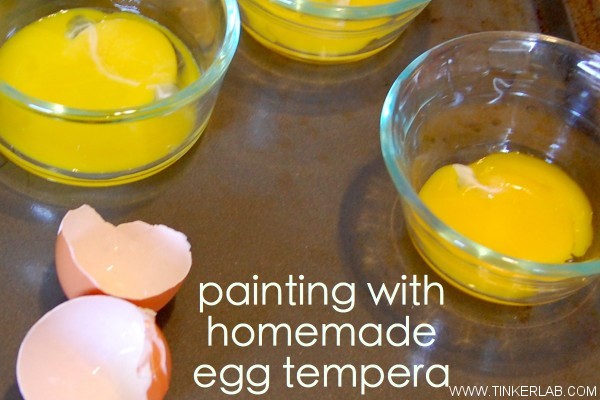
Interesting, right? So this is where those big, bright bottles of kid-friendly tempera paint get their name from.
I borrowed this recipe from Kid’n’Kaboodle, and if you click over there you’ll find an enormous list of recipes that will keep your little artists busy for a long time.
This project doesn’t take very long to set up, kids will enjoy making their own paint from eggs (unless they’re allergic or hate eggs, of course), and once the paint dries it has a gorgeous, shimmery patina that makes it painting-worthy.
This post includes affiliate links
Ingredients
- Eggs
- Small bowls
- Paint Brushes
- Liquid Watercolors or Food Coloring
How to Make Tempera Paint
- Step one: Separate the yolks from the whites, and drop one yolk into each of your bowls.
- Step two: Mix food coloring or liquid watercolors into the egg
- Step three: Mix well
- Step four: Paint
Separate the yolks from the whites, and drop one yolk into each of your bowls.
My 3.5 year old chose three colors to add: Purple, Sparkly Red, and Sparkly Blue. My favorite paint to add are Sax Liquid Watercolors. The bottles are inexpensive, last forever, and come in a huge range of colors. Seriously the best investment as we’ve had our bottles for years.
As soon as my one year old began mixing the purple into the egg yolk, my older daughter commented on how purple and orange mix together to make brown. Not her desire, exactly, but she didn’t seem to mind and it was a great little unintended lesson in color mixing.
Paint with Tempera Paint
- Card stock or other heavy-weight paper (optional)
- Sharpie Pens (optional)
With our homemade tempera paint ready, we got busy painting. Quite a lot of painting, actually.
I joined in too and it occurred to me that this transparent paint would make a beautiful luminous sheen over some bold Sharpie marks. I offered my kids Sharpies, and they thought it was a great idea too.
Do your kids love Sharpies as much as mine do? My kids go bananas over Sharpies and I sometimes wonder if it’s because they really are all that wonderful or if it’s because I keep them on a super-high shelf, buried behind old taxes and holiday Silverware.
This was a great move, and the effect was as pretty as I had imagined.
My toddler isn’t so deft with the Sharpie and I had to keep a sharp eye on her. She also insisted on the famous paint-draw technique, which kept me busy. How I even snapped this photo I’m not sure.
Before we wrapped it up, they wanted to collaborate with my on my drawing. Rainbow asked me to draw her a sheep, and then the two of them went to town painting in and around the scene.

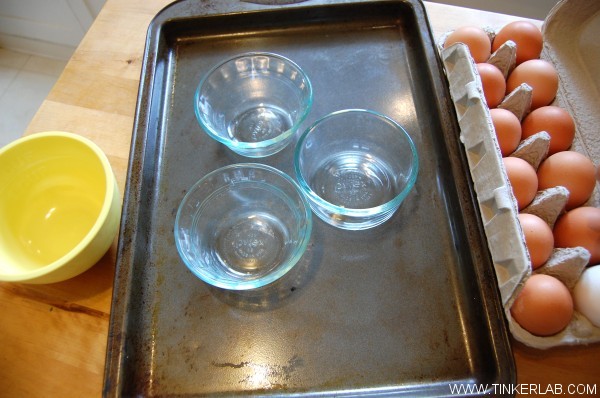
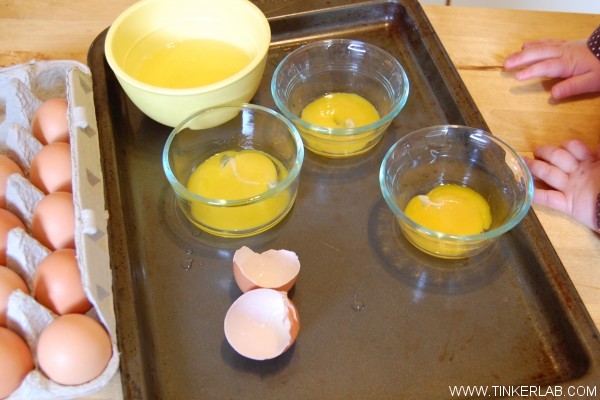
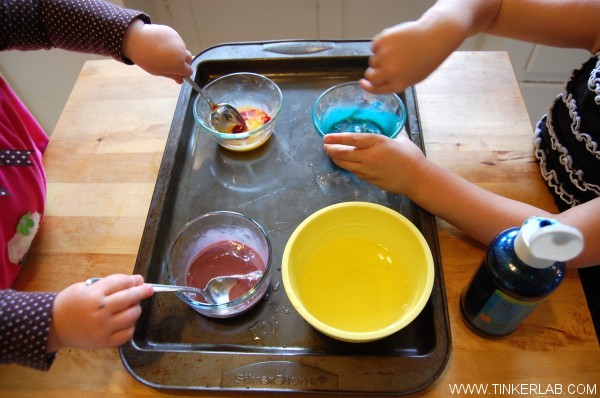
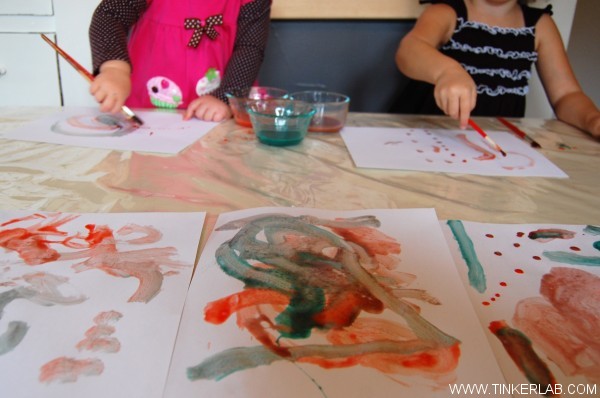
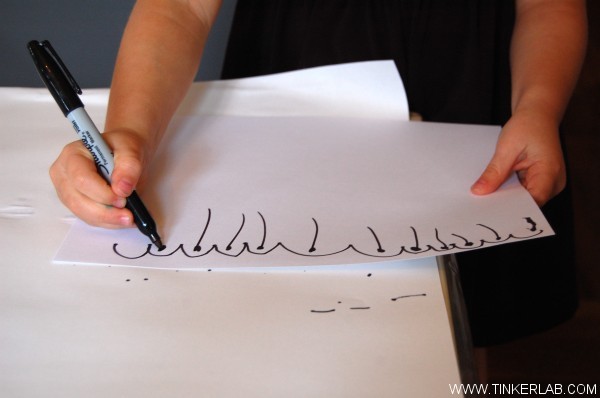
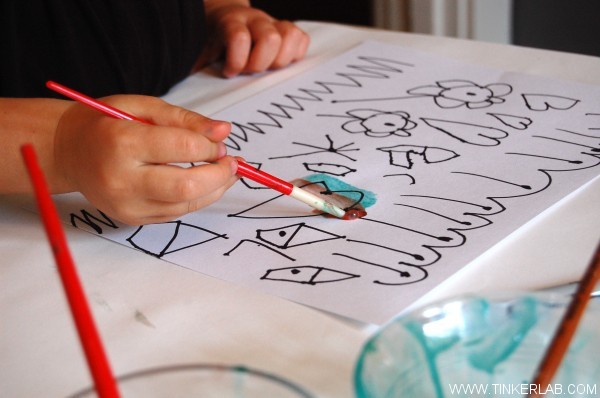
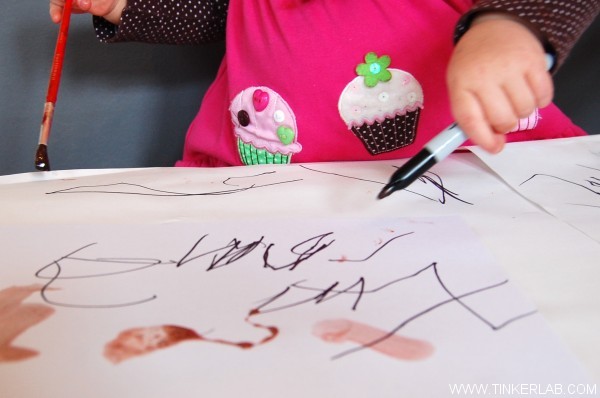
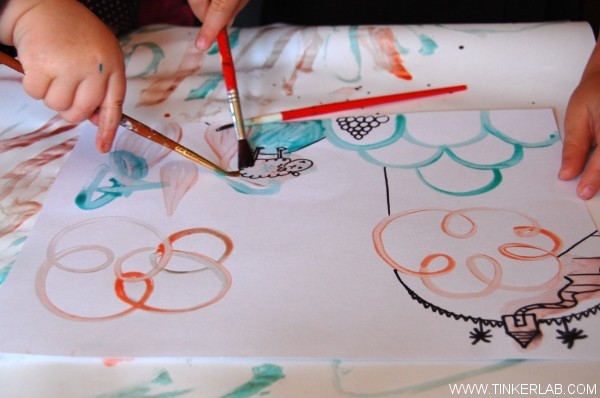

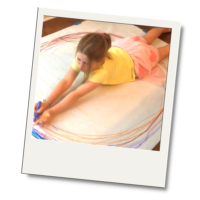
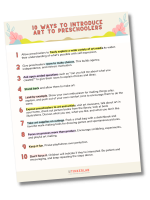
We made egg tempera paint last year using natural pigments like the old masters. Spices like turmeric and paprika work well, as does ground up chalk or charcoal, and also berry juices. Apparently it’s a very stable and long lasting paint, which is why so many of the early Renaissance masters artwork has survived so well.
I’m so glad you mention using natural pigments. This occurred to me too, but as I’ve been recovering from a big cold I barely had the attention span to pull off the watercolors! We’ll have to try this again with your recommendations. Thank you, Jude!
Great post. Love the idea of making your own paint with eggs. You always surprise me with what you come up with! I remember in college having a class which involved making traditional egg tempera and other old master techniques.Â
That sounds like a great class, Melissa! I know I would have loved that. And you surprise me, too 🙂
Crazy! This was my post today – although we used a different method. Didn’t you love the surface when it was dried?
http://mamascouts.blogspot.com/2012/03/exploration-lab-grind-your-own-paint.html
That is crazy, Amy! The surface is gorgeous and because of it I know I’ll be making my own egg tempera again soon. Okay, off to check out your take on this…
I can not wait to try this with my little ones this Spring!
It’s so rewarding to make your own paints, and to teach kids about the history of paint along the way. I hope you guys enjoy it.
This is so cool- and I learned why they are called tempera paints, which is, of course a plus. I can’t wait to try this soon!
so awesome!!!
and i totally concur on the sharpie fascination! (i think it’s the fact that they’re “mom’s special markers” which i only share on occasion that gives them mystique!)
Its a really nice activity, but I would like to know how long the paint lasts or if the paintings go bad a few days later because of the presence of the eggs
Good questions, Kiruthika! The paint dries unbelievably fast, and was favored by the Renaissance painters for its stability. So there’s no fear of it going bad. There are two differences between this project and the more traditional approach: I used liquid watercolors instead of dry pigments (shouldn’t be a problem) and there’s an extra step of rolling and drying the yolk sack before pouring it out that I skipped to make this simpler. I doubt that would make too much of a difference but if you want to create something archival, you may want to read up on the traditional approach. The only other thing I’ve read about the paint that may pose a problem is that it can flake off, but I haven’t seen that as a problem. If you do try it, I’d love to hear how it goes for you!
I love collaborative art! Â My son likes it when I paint with him. Â He usually paints on my paper and then has me paint on his.
Isn’t it sweet, Trisha? I’m going to try to soak it up while they still love to do this. And maybe we’ll still collaborate when they’re grown-ups too.Â
What the heck are “sharpies”?
You made me laugh, Diane, because we have Sharpies coming out of the seams of our house 🙂 Sharpies are simply permanent markers. http://www.sharpie.com/Pages/GlobalLanding.aspx
does it smell?
Hi Sophie!
No, it doesn’t smell at all. Isn’t that surprising?
Rachelle
I was thinking of making my own Tempera paint with natural colouring (made with fruits and/or vegetables). Do you think that this would work? Thank you
It will work great!
[…] Tempera jajowa stanowi dawną technikę malarstwa znaną od starożytności. Przepis jest naprawdę prosty – wystarczy drobno pokruszoną pastele lub barwnik spożywczy wymieszać z odrobiną wody i żółtkiem. KLIK […]
[…] out this activity where kids can make their own tempera paint from real […]
[…] Homemade Egg Tempera Paint by TinkerLab […]
[…] you need additional detailed step by step instructions with photos then check out this post. Be sure to try sketching out a picture and use your homemade tempera to complete the […]